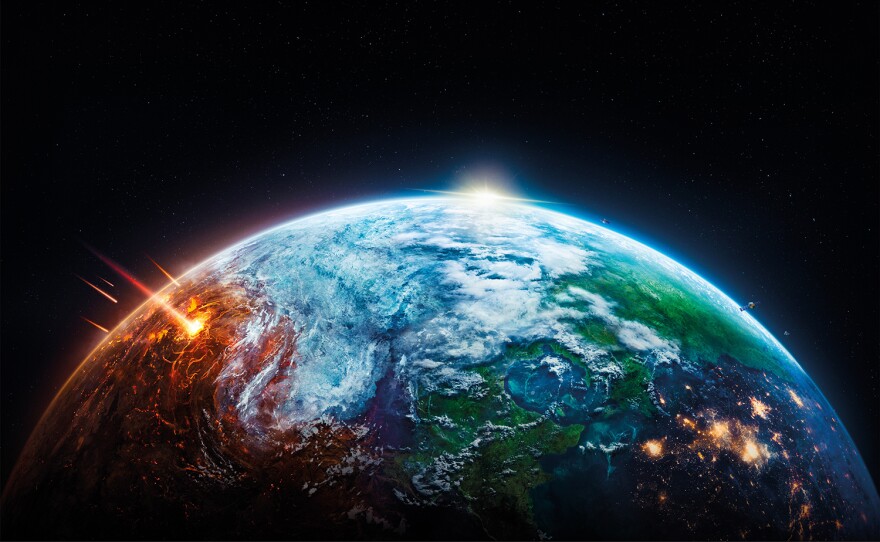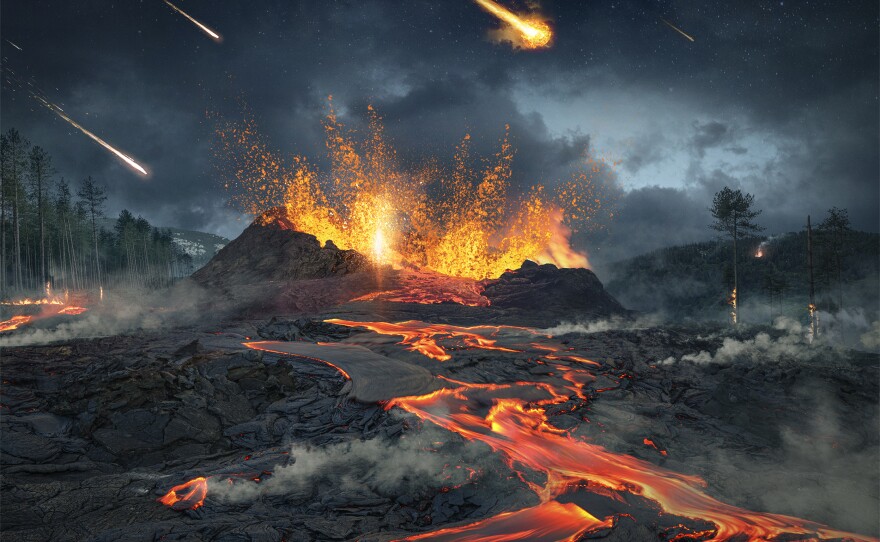Premieres Wednesdays, Oct. 4 – Nov. 1, 2023 at 9 p.m. on KPBS TV / PBS App
Dive into the most dramatic events in Earth’s 4.5-billion-year history, from its birth to the emergence of humanity. How did a hellscape of molten lava transform into a lush, green, watery planet filled with life? With dazzlingly realistic animation based on the latest research, each of these five episodes brings to life long-lost worlds that ultimately led to the one we know today.

EPISODE GUIDE:
Episode 1: “Birth of the Sky” Premieres Wednesday, Oct. 4 at 9 p.m. on KPBS TV - Today, Earth is enveloped by a thin veil of gas, a narrow band of atmosphere that protects a world covered in lush green vegetation, deep blue oceans, and abundant life. But 4.5 billion years ago, Earth was a very different place: a hellscape of molten lava and barren rock, under relentless bombardment from meteors, and with no atmosphere whatsoever. So how did our familiar blue sky come to be? Breathtakingly realistic animations and a chorus of science experts reveal how the primordial inferno first gave rise to an orange-hued cauldron of toxic gasses that would be deadly to us today. Witness how the first drops of rain splashed down on the searing planet, setting the stage for the evolution of life. And discover how life itself helped create the air we all breathe today.
Episode 2: “Frozen” Premieres Wednesday, Oct. 11 at 9 p.m. on KPBS TV - 700 million years ago, Earth was a giant snowball cloaked in ice from pole to pole – a global freeze that held the planet in a stranglehold, threatening the survival of the earliest complex life. How did life manage to hold on in this forbidding world? Leading scientists investigate how this catastrophe may have become a catalyst for life to evolve in creative new ways as it bounced back from the brink – setting the stage for the astonishing complexity we see today.
Episode 3: “Life Rising” Premieres Wednesday, Oct. 18 at 9 p.m. on KPBS TV - For billions of years, life teemed in the oceans of planet Earth while the land was desolate and inhospitable. So how did life make the leap to land? Scientists explore how some of the earliest life emerged and invaded a barren, rocky landscape, eventually transforming it into a verdant, green world. Gripping visual effects reveal an alien landscape dominated by towering fungi before the arrival of plants. Witness how the first plants made landfall and partnered with fungi to create soil that would sustain them. And discover how, once life emerged on land, it fundamentally altered the very ground it grew on.
Episode 4: “Inferno” Premieres Wednesday, Oct. 25 at 9 p.m. on KPBS TV - 252 million years ago, the most devastating mass extinction of all time abruptly wiped out around 90% of all species on Earth. The culprits were the biggest volcanic eruptions the world has ever seen, emitting some 700 thousand cubic miles of magma and rock. Volcanic gasses permeated the atmosphere and acidified the oceans while toxic gasses destroyed the ozone layer, bathing the planet in destructive UV radiation. The event – now called “The Great Dying” – came close to wiping out all life on the planet. Follow scientists as they piece together geologic evidence from the deep past and clues from today’s ecosystems to discover how life made it through and evolved into the astonishing variety we see around us today.
Episode 5: “Humans” Premieres Wednesday, Nov. 1 at 9 p.m. on KPBS TV - The story of Earth can only be told because now, 4.5 billion years into its existence, a technological and self-aware animal species roams its surface, able to study the very planet that gave rise to it. But how exactly did Earth give rise to humans? Through stunningly realistic animation, witness the cataclysmic asteroid strike that wiped out the dinosaurs, the tumultuous changing climates that allowed early primates to spread across the planet, and the geologic events that created the conditions for the evolution of an animal that walks upright on two legs. Explore the power and paradox of humanity’s profound impact on our planet, and ponder the question of how we may shape its future.
Watch On Your Schedule:
The series will be available to stream with the PBS App. Watch the best of PBS anytime, anywhere on the free PBS App. Stream your favorite PBS shows on-demand and livestream shows from your local station, all from your favorite device.
NOVA l PBS on Facebook / Instagram





